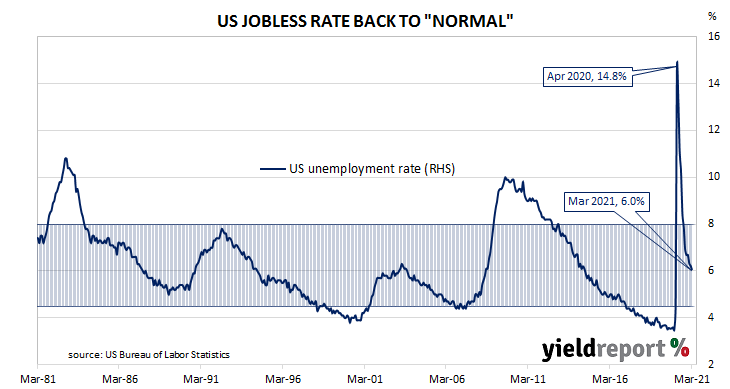Summary: March non-farm payrolls increase much more than expected; January, February figures revised up; jobless rate declines, participation rate up; “more momentum building”; jobs-to-population ratio up again; underemployment rate falls below 11%; hourly pay growth slows.
The US economy ceased producing jobs in net terms as infection controls began to be implemented in March 2020. The unemployment rate had been around 3.5% but that changed as job losses began to surge through March and April of 2020. The May 2020 non-farm employment report represented a turning point and subsequent months provided substantial employment gains. Changes in recent months have been more modest but mostly positive.
According to the US Bureau of Labor Statistics, the US economy created an additional 916,000 jobs in the non-farm sector in March. The increase was well above the 600,000 which had been generally expected earlier in the week and almost double the 468,000 jobs which had been added in February after revisions. Employment figures for January and February were revised up by a total of 156,000.
The unemployment rate declined again, from February’s rate of 6.2% to 6.0%. The total number of unemployed decreased by 262,000 to 9.710 million while the total number of people who are either employed or looking for work increased by 347,000 to 160.558 million. The additional number of people in the labour force led to rise in the participation rate from February’s rate of 61.4% to 61.5%.
ANZ economist Hayden Dimes said, “While employment remains down on its pre-pandemic peak by more than eight million, increased fiscal stimulus alongside an accelerating pace of vaccine rollout suggests there’s plenty more momentum building in the pipeline.”

US Treasury yields rose moderately on the day. By the close of business, the 2-year bond yield had added 2bps to 0.18%, the 10-year yield had gained 4bps to 1.72% and the 30-year yield finished 2bps higher at 2.36%.
One figure which is indicative of the “spare capacity” of the US employment market is the employment-to-population ratio. This ratio is simply the number of people in work divided by the total US population. It hit a cyclical-low of 58.2 in October 2010 before slowly recovering to just above 61% in late-2019. March’s reading increased from 57.6% to 57.8%, continuing a rising trend which began in May 2020.

